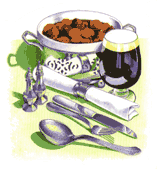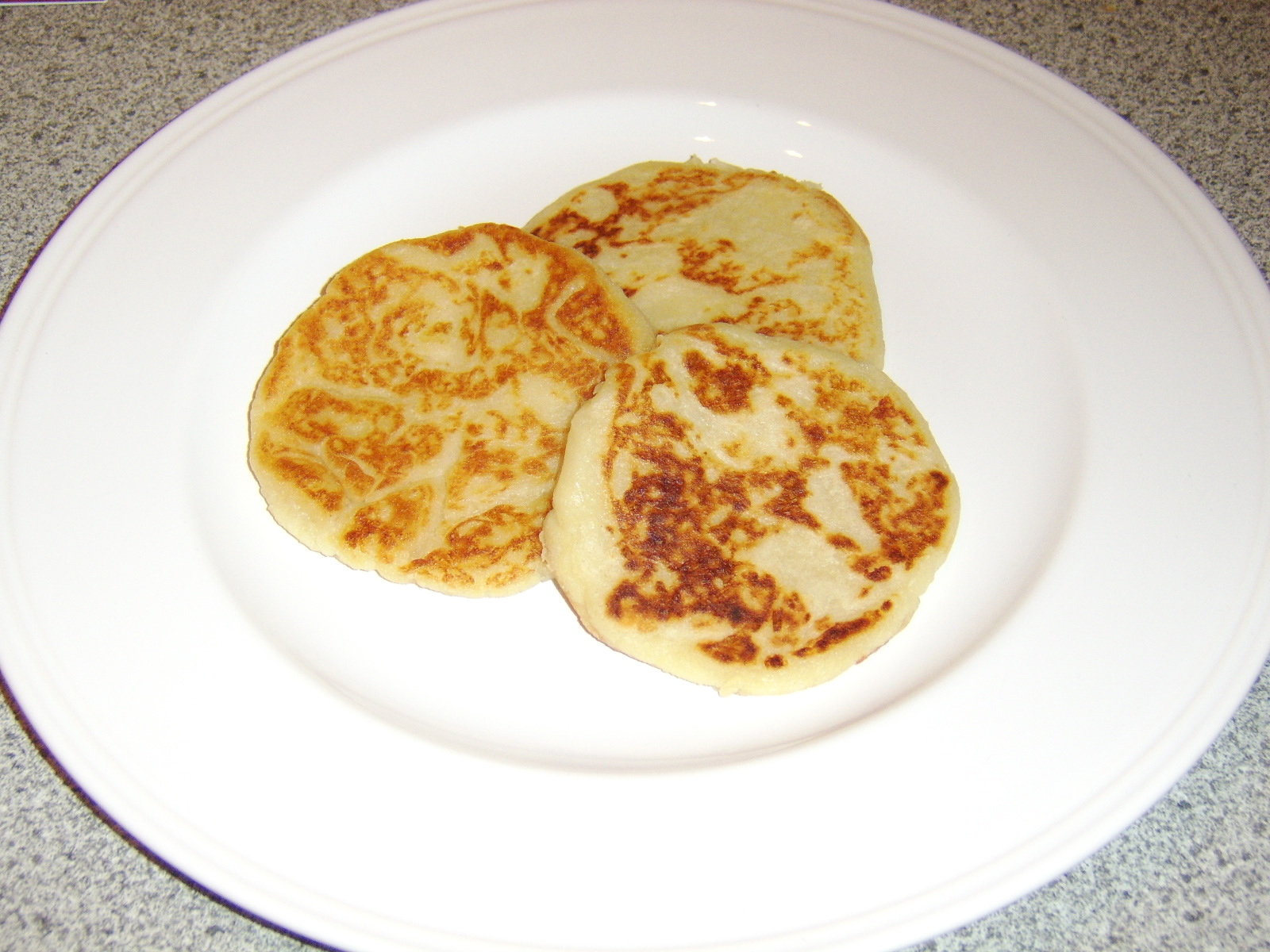The Table of Content


Family Research:









Available Help:



|

Below, please find a number of Scotland's traditional recipes (except Haggis) from various websites. We have attempted to provide you with a cross section of traditional fine foods from Scotland. We encourage everyone to visit each website and checkout all they have to offer. Enjoy !
Lamb Stew
This recipe and many others may be found at Scottish Recipes.
Ingredients:
| 650 | g | cubed lamb | | 25 | g | pearl barley | | 1 | | onion finely chopped | | 3 | | celery sticks - cut into chunks | | 225 | g | carrots - cut into chunks | | 25 | g | margarine | | 150 | ml | cider | | 150 | | stock | | | | salt and pepper | | | | Thyme - fresh or dried |
Directions:
1. Simmer the barley in a small pot for about 10 minutes then drain.
2. In a large pot melt the margarine and slowly cook the vegetables for 7 minutes. Add the lamb and stir.
3. Stir in the cider and stock, adding the seasoning and thyme and then the barley. Cover and cook for about an hour, stirring occasionally.
4. Serve with tatties, or add potatoes and extra stock to the recipe.
Tattie Scones Recipe
This recipe comes to us from HubPages website and Gordon Hamilton's "Traditional Scottish Recipes 78".
Tattie scones are very much a staple part of the Scottish culinary traditions. They are most often eaten at breakfast time but their versatility means that they can be enjoyed at any time of the day in a variety of different ways.
Tattie scones are most often made in triangular or segment shapes but on this occasion, I made circular ones, purely due to the way in which I intended to use them.

Ingredients:
| ½ | lb | potatoes (weighed after being peeled) | | 2 | oz | plain or all-purpose flour | | 1 | oz | butter | | | | generous pinch of salt |
Directions:
1. Put the peeled and chopped potatoes in to a pot and cover them with boiling water. Bring back to the boil and simmer for around twenty-five minutes until they are soft. Drain them well and return them to the empty pot.
2. Add the butter to the potatoes and mash them thoroughly before adding the sieved flour in two or three stages, stirring well with a wooden spoon. When the mixture has come together to form a dough, cover and allow to cool.
3. Lightly flour a chopping board or clean surface and if making circular tattie scones as I have done, separate the dough in to three pieces before forming each in to a ball and rolling out to a thickness of approximately ¼". If traditional shaped tattie scones are required, simply roll out the whole piece of dough and cut in to the required shapes.
4. Add a little vegetable oil to a non-stick frying-pan and bring it up to a medium heat before adding the tattie scones. Ensure that the heat is not too high or the scones will brown on the outside while still being raw and unpalatable on the inside. The tattie scones should take around three minutes on each side to cook and nicely brown.
5. When the scones are ready, they can either be eaten straight from the pan, allowed to cool and enjoyed with such as butter or jam, or even re-heated at a later time as part of perhaps a traditional Scottish breakfast. They should easily keep for two or three days in an airtight container or in the refrigerator.
Baked Brown Trout
Trout, freshly caught from the river, is a dependable dish to have in Scottish restaurants, especially in the Highlands. In this recipe the fish cooks in its own juices, with baking foil keeping it moist. Quantities below are for four people. This is one of the recipes found at rampantscotland.com .
Ingredients: | 4½ | lb | trout | | 4 | Tbsp | dry vermouth | | 2 | Tbsp | olive oil | | | | sea salt | | | | freshly ground black pepper | | 4 | sprigs | fresh herbs (dill, fennel, chives or parsley) | | 1 | | lemon |
Directions:
1. Clean the trout if required, remove the fins and wipe with kitchen paper.
2. Season the inside of the trout with salt and pepper and insert the herbs.
3. Cut four pieces of kitchen foil into oval shapes which are long enough to take the fish plus an extra 3" foil.
4. Brush the foil with olive oil and place each trout in the centre. Brush the outside of the fish with olive oil, season with salt and pepper and pour a tablespoon of vermouth over each fish.
5. Pull the foil up to make a boat shape for the fish and pleat over the top to totally enclose the fish, making sure it is pinched together.
6. Place on a baking sheet and bake in a pre-heated oven at 450ºF for 8 to 10 minutes.
7. The time will vary, depending on how plump the fish are. Check by opening up foil and examining the flesh at the thickest part. There should be no opaqueness or pinkness.
The fish can be served in the foil with fresh vegetables.
Scotch Broth
Mutton was a traditional ingredient in Scottish meals and when Scotch Broth soup was being made, the mutton would often be used as the main course. Please visit scotlandby.com for more like this one.
Serves 6
Ingredients: | .5 | g | mutton or neck of one-year-old lamb | | 1.8 | l | water | | 100 | g | pearl barley | | 100 | g | dried peas soaked overnight | | 1 | lg | carrot | | 1 | sm | leek | | 1 | sm | diced turnip | | 1 | tsp | chopped parsley |
Directions:
1. Trim any excess fat from the mutton and put in a large pan with the water, pearl barley, peas and seasoning. Bring to the boil and simmer for an hour.
2. Chop the carrot, onion, leek and turnip, add to the pot and return to the boil. Simmer for another 30 minutes or until the vegetables are cooked but still slightly firm.
3.Remove the mutton from the pot and trim off the meat (into small pieces if they are to be served with the soup) and return it to the pot, discarding the bone.
4. Skim off any fat season to taste and garnish with parsley.
There are hundreds of Scottish recipes available to you when you visit the websites above.
  
|





